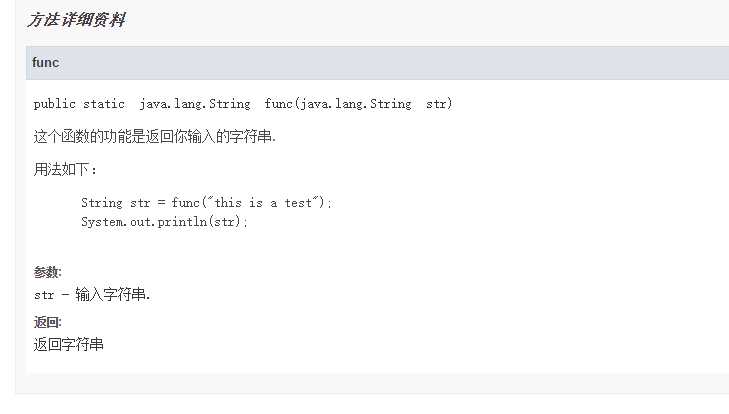标签:html标签 through sch cep oss src which other art
参考:http://www.w3school.com.cn/tags/tag_pre.asp
javadoc 生成帮助文档时,注意以下几点:
1、函数功能描述的结尾一定要有句号,英文句号或中文句号均可。不然会有方法摘要里会出现后边一大片内容。
2、换行用<p>
3、<pre> 元素可定义预格式化的文本。被包围在 pre 元素中的文本通常会保留空格和换行符。而文本也会呈现为等宽字体。
public class JavadocDemo { /** * 这个函数的功能是返回你输入的字符串. * <p> * 用法如下: * <blockquote> * <pre> * String str = func("this is a test"); * System.out.println(str); * </pre></blockquote> * @param str 输入字符串. * @return 返回字符串 */ public static String func(String str) { return str; } }
生成的帮助文档如下

参考
1、参考java源码的Object类wait()方法
/** * Causes the current thread to wait until another thread invokes the * {@link java.lang.Object#notify()} method or the * {@link java.lang.Object#notifyAll()} method for this object, or * some other thread interrupts the current thread, or a certain * amount of real time has elapsed. * <p> * This method is similar to the {@code wait} method of one * argument, but it allows finer control over the amount of time to * wait for a notification before giving up. The amount of real time, * measured in nanoseconds, is given by: * <blockquote> * <pre> * 1000000*timeout+nanos</pre></blockquote> * <p> * In all other respects, this method does the same thing as the * method {@link #wait(long)} of one argument. In particular, * {@code wait(0, 0)} means the same thing as {@code wait(0)}. * <p> * The current thread must own this object‘s monitor. The thread * releases ownership of this monitor and waits until either of the * following two conditions has occurred: * <ul> * <li>Another thread notifies threads waiting on this object‘s monitor * to wake up either through a call to the {@code notify} method * or the {@code notifyAll} method. * <li>The timeout period, specified by {@code timeout} * milliseconds plus {@code nanos} nanoseconds arguments, has * elapsed. * </ul> * <p> * The thread then waits until it can re-obtain ownership of the * monitor and resumes execution. * <p> * As in the one argument version, interrupts and spurious wakeups are * possible, and this method should always be used in a loop: * <pre> * synchronized (obj) { * while (<condition does not hold>) * obj.wait(timeout, nanos); * ... // Perform action appropriate to condition * } * </pre> * This method should only be called by a thread that is the owner * of this object‘s monitor. See the {@code notify} method for a * description of the ways in which a thread can become the owner of * a monitor. * * @param timeout the maximum time to wait in milliseconds. * @param nanos additional time, in nanoseconds range * 0-999999. * @throws IllegalArgumentException if the value of timeout is * negative or the value of nanos is * not in the range 0-999999. * @throws IllegalMonitorStateException if the current thread is not * the owner of this object‘s monitor. * @throws InterruptedException if any thread interrupted the * current thread before or while the current thread * was waiting for a notification. The <i>interrupted * status</i> of the current thread is cleared when * this exception is thrown. */ public final void wait(long timeout, int nanos) throws InterruptedException { if (timeout < 0) { throw new IllegalArgumentException("timeout value is negative"); } if (nanos < 0 || nanos > 999999) { throw new IllegalArgumentException( "nanosecond timeout value out of range"); } if (nanos > 0) { timeout++; } wait(timeout); }
2、>>Html标签定义<<
标签:html标签 through sch cep oss src which other art
原文地址:http://www.cnblogs.com/LiuYanYGZ/p/6095895.html